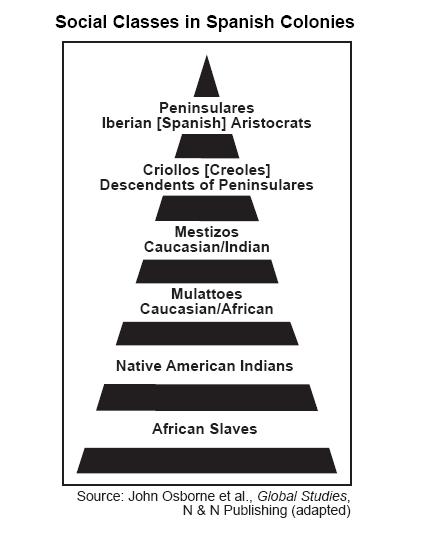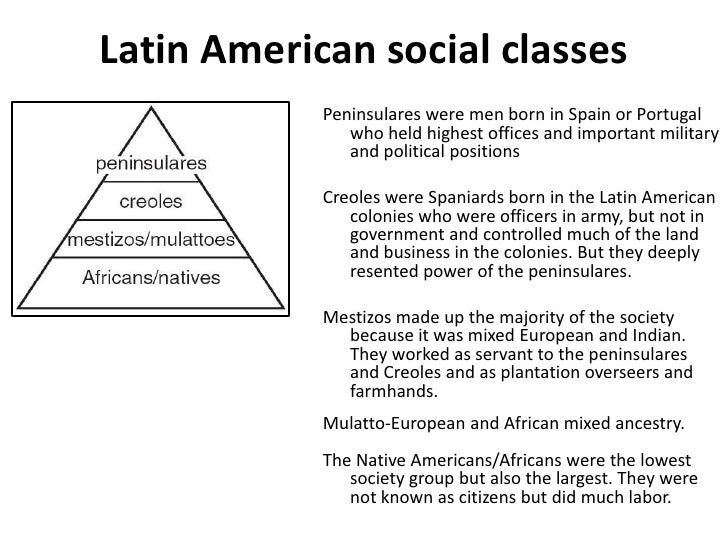Post by pieter on Jun 25, 2017 8:05:43 GMT -7
Latin America Social Hierarchy

Buying slaves in Havana, Cuba in 1837
The Latin America social hierarchy was based on social stratification which was widely used in Latin America for social control. This classification determined a person’s influence, control, supremacy and individual rights in the Latin American society and these factors were determined on the basis of segregation of people.
The social class system is always dependent on certain rules or specification on which the social partition of that society is based on. Same was the case with social stratification in Latin America. Actually the Latin America social hierarchy was totally structured on one thing – the place one was born. Simply if a person was born in Spain then he automatically came under the superior class. So these superior social classes enjoyed more power, control, economic freedom along with services from lower classes.
The social classes in Latin America were prearranged in the manner that is described in brief as below. The hierarchy is explained starting from the highest rank group having utmost power and influence in Latin America and finishing with the social group having lowest rights, control and power. Let us have a quick look at the Latin America social hierarchy.

Peninsulares
The highest social group in the Latin America social hierarchy was of Peninsulares. These were people who were born in Spain not in Latin America. They were considered of true blood. This social class was also termed as Spaniards. These people enjoyed top most power, rights, authority and economic favors in the society. Entire political powers were also under their administration. They controlled the entire government along with economic affairs of the society.
Peninsular

Colonial hierarchy in the Spanish colonies
Peninsular, Spanish Peninsular, plural Peninsulares, also called Gachupín, or Chapetón, any of the colonial residents of Latin America from the 16th through the early 19th centuries who had been born in Spain. The name refers to the Iberian Peninsula. Among the American-born in Mexico the peninsulars were contemptuously called gachupines (“those with spurs”) and in South America, chapetones (“tenderfeet”). They enjoyed the special favour of the Spanish crown and were appointed to most of the leading civil and ecclesiastical posts under the colonial regime. As a result, the creoles, or persons of Spanish ancestry born in the Americas, were relegated to second-class status, though they, in turn, enjoyed many advantages over Indians (Native Americans or Amerindians), blacks, and those of mixed blood. Peninsulars were also given preference in commerce, whereas creoles were severely restricted in their business activities. Thus, there was enmity between the two groups. With the achievement of independence from Spain in the early 19th century, the creoles moved into the first rank of Latin American society, and the peninsulars were, in many cases, driven out.

Free Women of Color with their Children and Servants in a Landscape, ca.1796

Sources:
www.hierarchystructure.com/latin-america-social-hierarchy/

Buying slaves in Havana, Cuba in 1837
The Latin America social hierarchy was based on social stratification which was widely used in Latin America for social control. This classification determined a person’s influence, control, supremacy and individual rights in the Latin American society and these factors were determined on the basis of segregation of people.
The social class system is always dependent on certain rules or specification on which the social partition of that society is based on. Same was the case with social stratification in Latin America. Actually the Latin America social hierarchy was totally structured on one thing – the place one was born. Simply if a person was born in Spain then he automatically came under the superior class. So these superior social classes enjoyed more power, control, economic freedom along with services from lower classes.
The social classes in Latin America were prearranged in the manner that is described in brief as below. The hierarchy is explained starting from the highest rank group having utmost power and influence in Latin America and finishing with the social group having lowest rights, control and power. Let us have a quick look at the Latin America social hierarchy.

Peninsulares
The highest social group in the Latin America social hierarchy was of Peninsulares. These were people who were born in Spain not in Latin America. They were considered of true blood. This social class was also termed as Spaniards. These people enjoyed top most power, rights, authority and economic favors in the society. Entire political powers were also under their administration. They controlled the entire government along with economic affairs of the society.
Peninsular

Colonial hierarchy in the Spanish colonies
Peninsular, Spanish Peninsular, plural Peninsulares, also called Gachupín, or Chapetón, any of the colonial residents of Latin America from the 16th through the early 19th centuries who had been born in Spain. The name refers to the Iberian Peninsula. Among the American-born in Mexico the peninsulars were contemptuously called gachupines (“those with spurs”) and in South America, chapetones (“tenderfeet”). They enjoyed the special favour of the Spanish crown and were appointed to most of the leading civil and ecclesiastical posts under the colonial regime. As a result, the creoles, or persons of Spanish ancestry born in the Americas, were relegated to second-class status, though they, in turn, enjoyed many advantages over Indians (Native Americans or Amerindians), blacks, and those of mixed blood. Peninsulars were also given preference in commerce, whereas creoles were severely restricted in their business activities. Thus, there was enmity between the two groups. With the achievement of independence from Spain in the early 19th century, the creoles moved into the first rank of Latin American society, and the peninsulars were, in many cases, driven out.

Free Women of Color with their Children and Servants in a Landscape, ca.1796

Sources:
www.hierarchystructure.com/latin-america-social-hierarchy/



